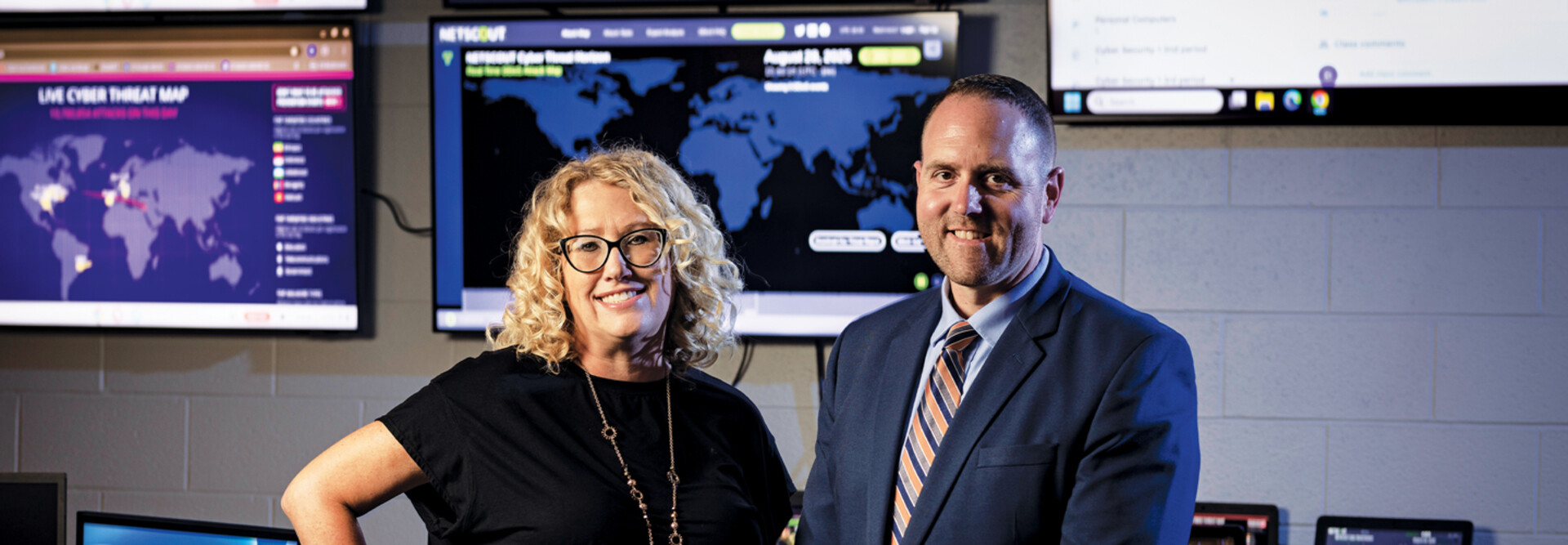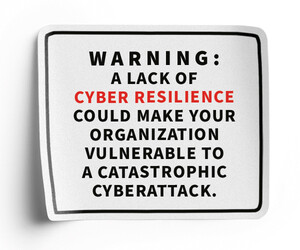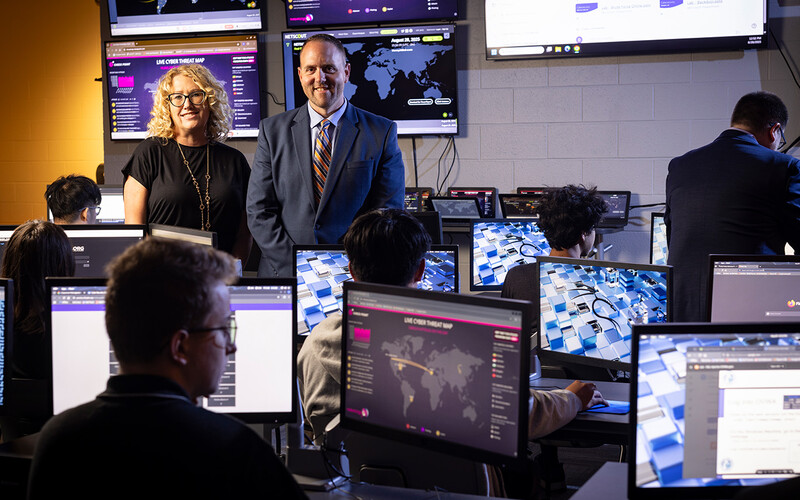Network protection. Detecting and mitigating vulnerabilities. Disaster recovery and business continuity. It’s subject material that might be expected at an annual conference for IT professionals, but now it’s also on the syllabus at an Ohio high school.
An offering of the career and technical education (CTE) program at Beavercreek City Schools, the coursework is part of its Cybersecurity Pathway, which launched in fall 2024. Cybersecurity 1 covers basic security safeguards for desktops, networks and system applications. Students who pass that can take Cybersecurity 2 and Cybersecurity Defense and Reinforcement, and they can potentially earn college credits and valuable industry certifications.
“We’re giving our students what they want and what area employers need,” says Bobbie Fiori, BCS assistant superintendent of curriculum and special services. Prior to the pathway’s implementation, she explains, the district conducted a survey that showed a high level of student aptitude for and interest in cybersecurity. With that information, school leaders considered booming job market for new and experienced professionals in the industry, “and we decided that now was the perfect time.”
Click the banner below to learn how to keep your district cyber resilient.
The district won an equipment grant from the Ohio Department of Education and Workforce. At the same time, seeking advice on its curriculum, it partnered with a local technology business that contracts with a nearby Air Force base. Finally, the district brought in the BCS IT department to give students opportunities for work-based learning.
“Some of these students can tell you how to do highly technical things in just a few seconds,” Fiori says. “This program is a chance for our students to use these powers for good while giving them the kind of experience that companies want to see.”
Today, she adds, close to 130 students are taking cybersecurity classes at BCS, and many are applying for professional credentials through sector leaders, including IBM and CompTIA. She can’t predict how many will eventually choose to pursue careers in the field, but she’s confident that those who do will have what they need to start off on the right foot.
DISCOVER: Find out how other organizations are tackling cybersecurity.
“There aren’t a lot of jobs, like there are in cybersecurity, where you can make $60,000 to $70,000 per year right out of high school,” Fiori says. Some students may attend college while others go straight to work, “but either way, if this is their interest, we’re going to try to make sure they’re prepared.”
Districts See Real Student Excitement in Cybersecurity Classes
It’s a common scene in a growing number of K–12 classrooms: When instructors shift the subject to cybersecurity, students move to the edge of their seats.
According to Charlene Cooper, director of CYBER.ORG., this reaction “shouldn’t be surprising.”
“These kids are gaming, they’re online — they’re digital natives immersed in technology. IT, and cybersecurity specifically, is a topic that a lot of students are naturally curious about.”
CYBER.ORG provides cyber education resources and training to teachers and students at hundreds of schools across the country, Cooper explains. “You can tell a student about the careers in this field and all of the different possibilities, but what they really want is active engagement and ways to apply what they learn to solving authentic problems.”
One experienced educator who agrees with that message is Suffern Central School District’s Ariel Sanzo. A special education teacher by trade, Sanzo is also the lead teacher for the New York school system’s popular Cybersecurity Academy.
The high school program offers three one-credit courses for students in 10th through 12th grades, she explains. The first introduces students to content required for professional certifications, while the others raise the bar with structured cyber competitions and job shadowing with local professionals.
In one unit, students learn to build a computer and implement the requisite security protections; in another, they hear from professionals in the field, such as an attorney who specializes in cybersecurity law.
“Students are so used to only taking classes that they have to take to graduate,” Sanzo notes. “What’s amazing about this is how excited they are to be here. They see all of the different places they can go with cybersecurity, and it makes them want to learn even more.”
READ MORE: Rural districts are creating a talent pipeline for local businesses.
14%
The percentage of organizations that are confident that they have adequate cybersecurity talent on staff
Source: World Economic Forum, “Global Cybersecurity Outlook 2025,” January 2025
Cybersecurity Takes Off at Chandler Unified School District
At Chandler Unified School District in Arizona, CTE Emerging Technologies Coordinator Janet Hartkopf knows something about student excitement for learning. Since 2019, when the district established its Institute of Cyber Operations and Networking at one of its high schools, interest in coursework related to cybersecurity “has been absolutely overwhelming,” Hartkopf says.
Today, CUSD offers cybersecurity classes through partnerships with Chandler Gilbert Community College and the University of Arizona. Students can attain an Associate of Applied Science degree in cybersecurity, and they can earn industry credentials, including CompTIA’s Security+ and the EC-Council’s Certified Ethical Hacker designation.
Last semester, Hartkopf adds, CUSD became the first K–12 district in the U.S. to offer students the option to participate in a Google-sponsored cybersecurity clinic. Nearly 100 people signed up for the free program, and those who completed its requirements successfully were presented with a professional cybersecurity certificate from Google.
Several of the clinic graduates later took part in summer internships with the district’s IT department, Hartkopf says. With their new credentials in hand, she recalls, “you should have seen them. They couldn’t wait to get started.”















